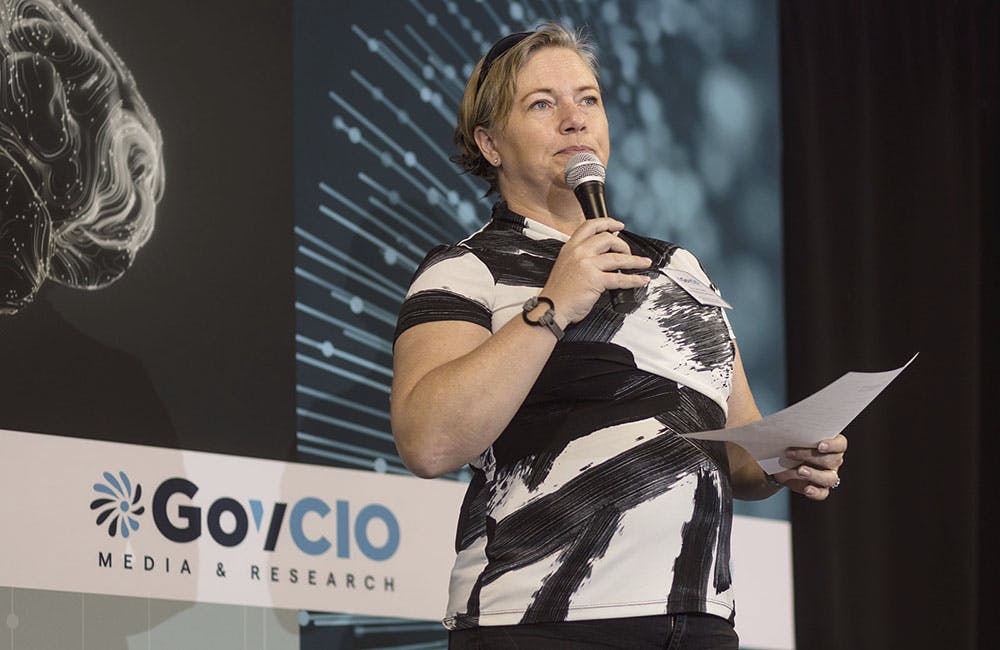5G Investments at Energy Poised to Transform Wireless Communications
The department’s national labs are developing new 5G capabilities.

The Department of Energy (DOE) has a wide-reaching mission spanning scientific innovation, nuclear security and maintaining the national power grid. CIO Ann Dunkin sees endless opportunities for 5G applications across the enterprise.
“5G has the potential to play a key role in every duty mission area because advancing national 5G capabilities will make an important contribution to combating climate change, creating clean energy jobs and promoting energy justice,” Dunkin said at the Federal Mobility Group and ATARC’s 5G symposium.
The department is driving a whole-of-department approach to take advantage of new wireless communication research and applications.
“Aligned with DOE’s participation in interagency working groups and national security efforts, we’ve launched an effort to establish an enterprise-wide 5G strategy,” Dunkin said.
DOE’s Office of Science, the single largest supporter of basic research in the physical sciences in the U.S., established its 5G initiative and awarded $6 million to research and development in 2021. Currently there are several 5G efforts underway at national labs, program offices and sites across the department.
“Researchers are applying 5G to our nuclear national security mission space to support advanced remote monitoring capabilities,” Dunkin said. “We’re actively engaged in research targeting a wide range of 5G applications and security questions across a variety of sectors impacting the lives of every American. From predicting and combating wildfires, to improving urban transportation and shipping infrastructure, to enhancing communications for first responders and environmental monitoring.”
Last year, DOE published a 5G catalog showcasing the national labs’ current and potential capabilities. At DOE’s Lawrence Berkeley National Lab, 5G is being used to enable vehicle infrastructure and infrastructure-infrastructure communications for autonomous vehicles.
The Pacific Northwest National Lab is working to develop a warning system leveraging telecommunication networks in AI/machine-learning analytics for real-time notifications for ferry operators.
The National Nuclear Security Administration, in partnership with the Lawrence Berkeley National Lab, is working to integrate “internet of things” sensors that support urban traffic and safety systems. Meanwhile, the National Renewable Energy Lab researchers have proposed a new service-based network architecture to prevent existing attack methods such as denial of service. And the Idaho National Laboratory has developed a unique communication control channel called wireless spectrum communication that could potentially expand the use of available radio spectrum.
“Scientists across DOE are applying 5G to improve the performance, availability, security and reliability of grid devices and services every day,” Dunkin said. “These applications will become increasingly vital as we transition to the grid in the future, relying on more distributed and renewable energy sources to generate and transmit power across the nation, creating a more complex grid operating environment.”
While the 5G landscape introduces a breadth of capabilities, it also brings new security concerns. Dunkin said DOE is staying on top of technology trends and supply chain risks to understand how the U.S. can most effectively secure its 5G telecommunication infrastructure.
“A major driver of government-wide efforts to advance and secure 5G is the need to mitigate the economic, national security and other risks posed by cyber threats and vulnerabilities to the 5G infrastructure — particularly where the threats and vulnerabilities could disrupt the nation’s critical infrastructure,” Dunkin said. “And while 5G does represent a potential threat vector, DOE and others in the U.S. government are both adopting mitigations, such as supply chain risk management, and innovating through the research and development of secure radio access networks and associated standards to ensure safe adoption of 5G to support our missions. Basically, no new technology comes without risks, and we want to make sure that we limit those risks as much as possible.”
The key to successful 5G development and deployment, Dunkin said, is collaboration. Dunkin began her career at HP and has held technology leadership roles in both the private sector and the federal government. She believes 5G is a critical space for government and industry partnership.
“The speed of innovation and technology requires government and industry to work together to develop, deploy and secure 5G to deliver services to the American people,” Dunkin said. “We must seek opportunities to learn together, partnering in a whole of nation approach. … Our future as a global technology and communications leader depends upon our success in this space.”
5G is changing the way the world connects and communicates, and Dunkin is excited by the future of DOE’s work in this space.
“I’m really energized by the current opportunity 5G gives us to rethink what’s possible in communications technology,” Dunkin said. “Effective adoption, deployment and development of applications for advanced 5G wireless networks can enable new and enhanced national telecommunications capabilities. These new capabilities can be adaptive or uniquely configured for specific or dynamic applications, or provide the technological backbone that America needs to continue its leadership in this area. By leading next-generation advanced world’s technology, we can build the infrastructure needed to enable a tightly interconnected world.”
This is a carousel with manually rotating slides. Use Next and Previous buttons to navigate or jump to a slide with the slide dots
-

NSF Wants Industry Driving Quantum Innovation
The agency is pushing for partnerships to enhance the research community as Congress weighs additional legislation.
3m read -

White House Science Chief: US-Driven AI Sets Global Standards
Michael Kratsios outlined how American AI technology on the global stage will help standardize the tech and counter China’s influence.
5m read -

Modernizing Critical Infrastructure in the Face of Global Threats
Officials are expanding the latest strategies in boosting defense infrastructure, including securing satellite communications, upgrading enterprise-wide technology, optimizing data management.
20m watch -

Trump AI Orders Call for Speed in Building Infrastructure
The directives call for expanding AI infrastructure, streamlining federal permitting and promoting AI exports.
4m read -

DOD Accelerates Software Modernization with Agile DevSecOps Push
The Pentagon's software implementation plan tackles cultural hurdles and integrates security early to deliver critical capabilities faster.
6m read -

White House Unveils AI Action Plan to Secure Global Dominance
The strategy outlines steps to accelerate private sector innovation, build critical infrastructure and advance U.S. leadership in AI policy and security.
3m read -

VA's Platform One Powers Rapid Innovation to Bolster Digital Services
VA's Platform One accelerates software development timelines from weeks to hours, ultimately enhancing digital services for veterans.
5m read -

Federal Leaders Receive Federal IT Efficiency Flywheel Awards from GovCIO Media & Research
Five federal IT leaders received Flywheel Awards for driving innovation and modernizing technology at the Federal IT Efficiency Summit.
5m read -

Doing More with Less is Muscle Memory for IRS, Former Deputy CIO Says
Darnita Trower discusses her experience, the legacy she’s left behind and how she pushed the IRS to modernize itself,
20m watch -

Opinion: Original Intelligence Is the Missing Piece for AI Transformation
Limitations of AI agents and development drive growing needs for workforce development and "original intelligence."
3m read -

VA CIO Targets Modern IT and Smarter Workforce Alignment
Agency leaders told lawmakers they are focused on trimming legacy systems and restructuring its workforce to streamline operations.
3m read -

Pentagon's $200M AI Contracts Signal Broader Effort to Transform Talent
The Army is leveraging Silicon Valley, reservist programs and new hiring strategies to integrate critical digital skills in its ranks.
5m read
















